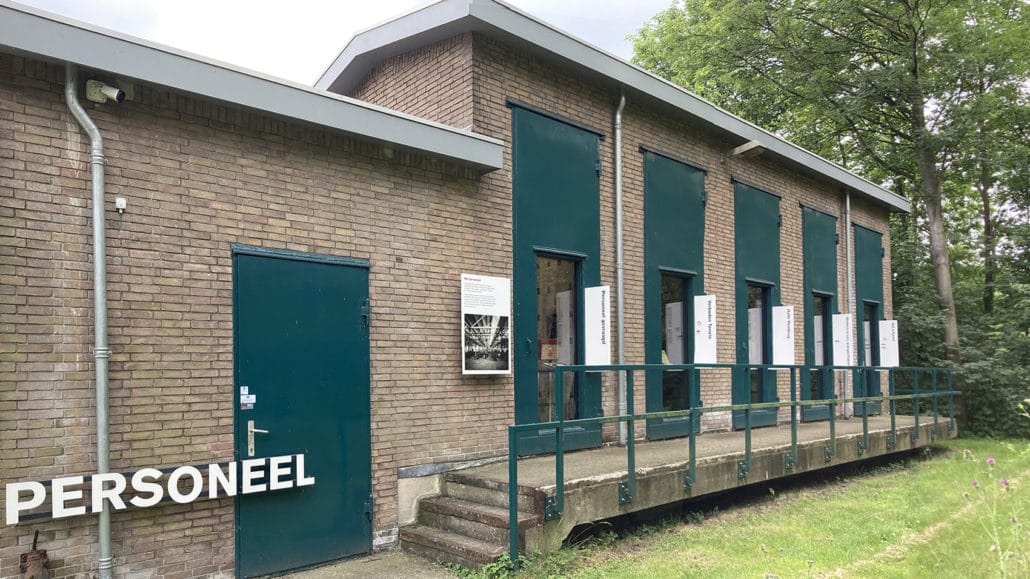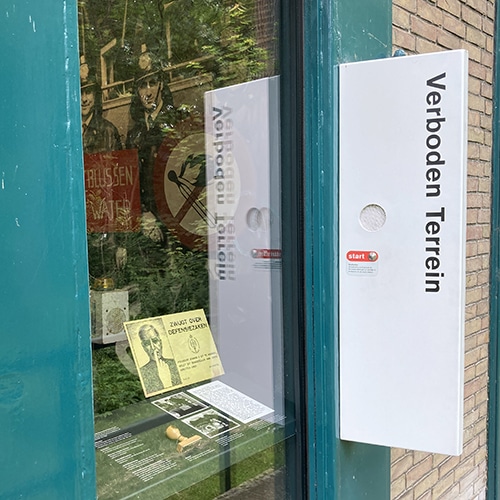Scroll down or click on a number in the image and read the English translation. Click on the arrow at the bottom right of the screen to go back up to the overview photo.
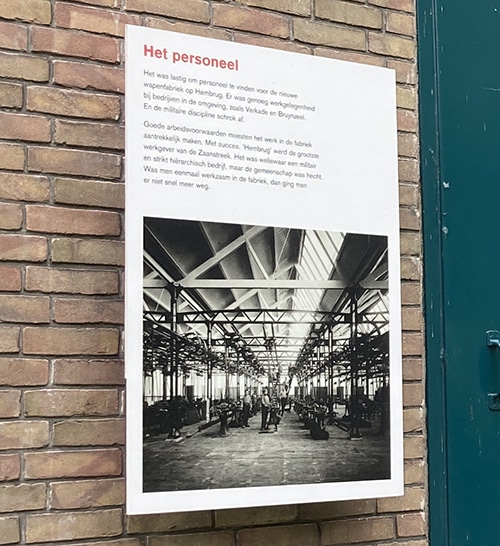
-1-
The personnel
Finding staff for the new arms factory at Hembrug proves challenging. There is plentiful employment at companies in the surrounding area, such as Verkade and Bruynzeel. Plus, people are put off by the military discipline.
To enhance the appeal of a job at the factory, attractive employment conditions are offered, and the tactic works: ‘Hembrug’ becomes the biggest employer in the Zaan region. Although it is a military and rigidly hierarchical business, it is a close-knit community. Once employed by the factory, people tended to stay.
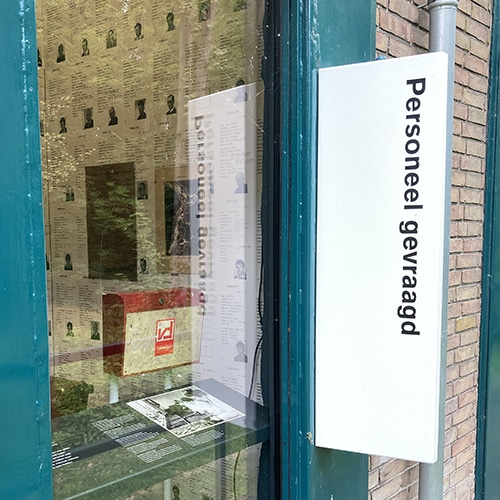
-2-
Staff sought
In 1895, Artillerie Inrichtingen relocates from Delft to Hembrug. The factory has to recruit staff in the Zaan region. Competition is tough. The company decides to offer attractive fringe benefits, such as a shorter working day, holiday entitlement, travel allowance, sick pay, a pension scheme, and its own medical service. It pays off!
Despite its attractive benefits, Artillerie Inrichtingen remains very much a hierarchical military company. Production workers are kept very much apart from highly-skilled technical staff, such as engineers, military officers, and office personnel. They have their own canteens and separate entrances and exits. Right at the bottom of the pile are the ‘blanks’, as they are known: the casual workers.
– ‘The Delft Row’
When the factory relocates to Hembrug, some of the staff from Delft move with it. To house them, thirty homes are built on Havenstraat. The row of houses is named after the principal administrator at the time, ‘Houtwipper’, but soon becomes known locally as ‘Het Delftse Rijtje’, The Delft Row.
– Suitcase belonging to Jan and Dirk Bout
Jan Bout works as a stoker at Artillerie Inrichtingen in Delft and takes this suitcase with him when he relocates to Zaandam with the company. His son Dirk, who uses the suitcase on his travels as a stoker on a ship, later becomes a stoker at the factory at Hembrug.
– ‘Hembrugfonds wordt donateur’ (Hembrug fund gives back) poster
Regulations of the Hembrug fund, 1920s
Artillerie Inrichtingen takes good care of its staff. The Hembrug fund provides support for staff in the event of sickness. Although not compulsory, many staff do take advantage of the fund, which existed until the end of the twentieth century.
– Company School exam paper
The Company School (Bedrijfsschool) is founded in 1937. It provides internal training for staff, but also attracts lots of young people from outside the company, many of whom go on to work in the factory after graduating.
– Eurometaal suggestion box
Artillerie Inrichtingen’s successor Eurometaal also takes its staff seriously, and gives monetary rewards for valuable ideas. Each year, the person with the biggest reward total is presented with a certificate in recognition of their dedication, ingenuity, and initiative.
– Women in the factory
Artillerie Inrichtingen is a very male-dominated environment. Over the years, more and more women join the ranks of its workforce, initially as secretaries, telephone operators, librarians, and seamstresses for the cartridges used to load gunpowder. Because of their fine motor skills, they are increasingly deployed in quality control for military production and in the laboratory.
-3-
No-Go Zone
Hembrug is a no-go zone. High fences seal the site off from the outside world. Even its own personnel aren’t allowed to roam freely. Employees are bound by secrecy. Every employee is pre-screened, and closely monitored while employed at the site.
Not only is the site a no-go zone, it is also a hazardous area. Ammunition is stored and explosives are tested in the woods. People remain constantly vigilant of accidents. There are warning signs everywhere. Anyone who fails to follow the safety rules is sacked on the spot.
– Gunpowder being incinerated by the ‘Zwarte pad’ path Unsafe munitions are destroyed at one of the incineration locations on the site, under the supervision of the security department and the fire brigade.
– Firefighter’s jacket Artillerie Inrichtingen has its own fire brigade, which is first on the scene in the event of a fire on site. Drills are held every Friday afternoon.
– Soundbox The soundbox is used during fire drills to reproduce sounds that are emitted during a fire.
– Sign with red-yellow flames
Signs like these were used by the company fire brigade during drills.
– Red EMERGENCY telephone This telephone is used as a direct line to the emergency services.
– Warning flag The red flag is used when assembled ammunition is being internally transported. The flag was also flown on the bunkers in the woods during munitions testing.
– Sign reading ‘Zwijgt over Defensiezaken’ (Do not discuss Defence Matters) (1940) Artillerie Inrichtingen warning sign displayed during the Second World War. Talking to outsiders about what goes on at the factory and on the site is strictly forbidden. ‘If somebody is trying to get information from you, report this at once to your immediate boss.’
– Artillerie Inrichtingen stamp with the words ‘Classified confidential/secret by A.I.’
– Checks at the gate The Security Service checks everyone entering or leaving the factory site. Taking anything off the factory premises is strictly forbidden.
– Reverse of staff card Violations and other specific things relating to the employee are noted on the reverse of the staff card. Everything is recorded, from arriving 30 minutes late for work to the fact that the woman next door reads the communist paper ‘De Waarheid’ (The Truth).
Soundbox
The soundbox is used during fire drills to reproduce sounds that are emitted during a fire.
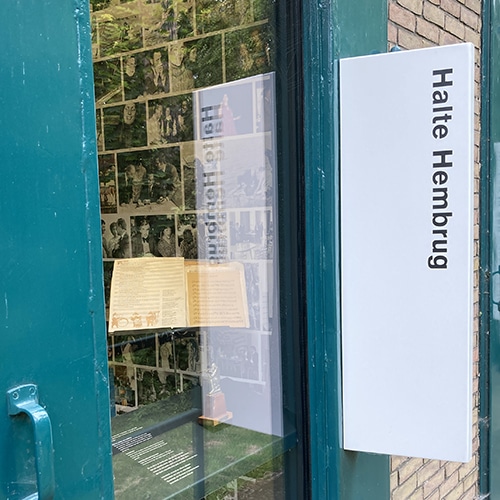
-4-
Hembrug Stop
Once employed at the factory, people tend to stay, many of them going on to celebrate 30th, 40th or even 50th employment anniversaries. Jobs and skills are often passed from father to son, and many employees meet their future spouses on the shop floor.
The staff are a close-knit community, despite the rigid hierarchy within the company. The staff association is formed in 1947, and organizes numerous activities for employees. At the annual staff dinner, ranks and social positions are abandoned for the evening.
– Drum kit This is the drum kit of ‘The Medleys,’ the staff band formed by the staff association. In the 1950s and 1960s, the band plays at events and parties held by Artillerie Inrichtingen.
– Trophies, prizes, and medals The staff association runs various clubs, including a drama club, fishing club, chess club, shooting club, bowling club, football club, hobby club, and a staff band. Competitions are regularly staged, with prizes up for grabs.
– Chessboard
This cardboard chessboard was used at a simultaneous chess exhibition between the staff association chess team and World Champion Max Euwe in July 1955. The wooden chess pieces were made by the company.
– Song lyrics for Eurometaal anniversary The staff sing this song at the 300th anniversary celebrations in 1979. Roughly translated, the final verse and the chorus go something like this:
300 years and still going strong, here we all are, singing a celebratory song, the future looks bright,
in our community lies our might,
Eurometaal, the biggest and the best,
Eurometaal, ahead of all the rest,
Eurometaal, king of land and water,
Eurometaal, let’s party like we ought to.
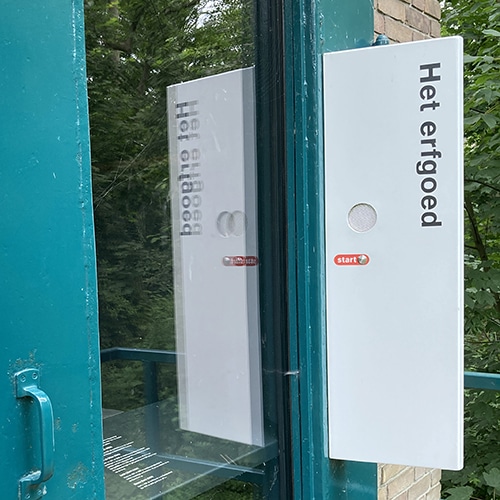
-5-
The heritage
The factory on the Hembrug site closes down in 2003. The buildings are vacated and swept clean. The machines are auctioned off. Boxes full of archives, photos, and documents are chucked into containers.
Peter de Vries, who has worked at the factory for more than thirty years, is upset to see how the heritage of one of the Netherlands’ oldest technical companies subjected to such rough treatment. He tries to salvage what he can. The items he rescued make up the collection of the Hembrug Museum, which has been part of the Zaans Museum since 2017.
From left to right:
– Dolf Fransen (1957) worked as a planner on the Testing Committee from 1981 to 2000. He drew up the timetables for munitions testing in the woods.
– Daniël Christiani (1932) worked as a test engineer in Machinefabriek Hembrug’s measuring chamber from 1948 to 1991.
– Peter de Vries (1948) was a despatch worker at AI and, later on, Eurometaal from 1971-2003. He founded the Hembrug Museum in 2003.
The tile tableau was presented in 1929 by officers of the Dutch army, to mark the 250th anniversary of the factory.
– Loek Libert (1934) worked as a company nurse at AI and, subsequently, Eurometaal from 1967-1996. He set up Eurometaal’s medical service.
– Simon Daas (1950) started as an apprentice at the Company School in 1967, where he also taught between 1992 and 2003.









